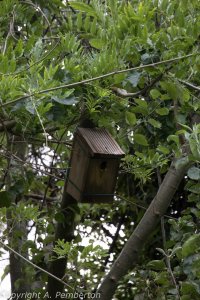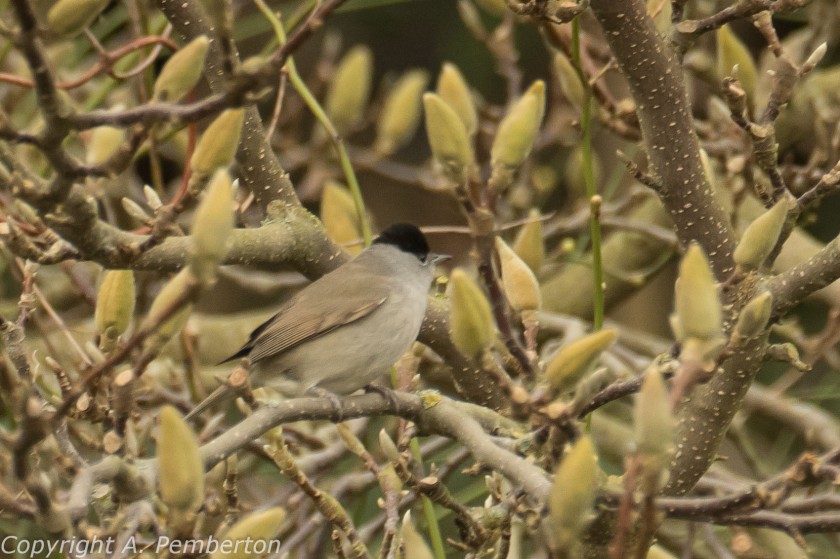
I continue to be terrible at updating this blog – a form of draft has sat on my phone since June – so I thought I’d compress a year’s worth of activity into a brief highlights package.
Birds
Chief amongst said 2017 highlights was the on-off saga of the nesting Wrens. In early May I noticed a (presumed) male Wren taking nesting material into the Tit box I’d put up on the apple tree the previous autumn. This was both exciting and amusing as most of the time he failed to fit the bark, twig or leaf through the hole and when he did a Coal Tit nipped in behind his back and pinched the material.

Having dialled it up to 11 to attract a mate he then quietened down and I naturally assumed that was that. Not so. After a few weeks he was back, loud and proud, constantly scolding everything in sight (me, the toothless cat, Robins,…..). Very strange I thought. The penny finally dropped once I saw a Wren carrying food to the box and leaving with a foecal sack – [insert phrase indicating hyperbolic excitement].
We barely had time to appreciate the situation let alone photograph it before it was all over: one Saturday in June, the day after I saw a young Wren stick it’s head out, the box was empty and the chick(s) had fledged and gone (or been eaten by a magpie or cat).
Other ornithological sightings of note included a Song Thrush singing February-March from various nearby gardens, a record eight swifts overhead in May, Jackdaw over in June, two House Martins over in October and regular Peregrines including one with prey that I very much hope was a parakeet. Locally, a Little Egret over HG station on the 18th of October was my first definite sighting in the area.
Bees
The warm and very dry spring with some hot spells encouraged many of the Mason Bees to emerge early (video here: Red Mason Bees). When they all disappeared leaving behind some unhatched cocoons I began to worry that only the males had hatched and the females would be too far behind for them to have the chance to meet. My fears turned out to be somewhat unfounded but nevertheless it was a poor year and as per my unpublished prediction we failed to break the 100 pupa barrier, only managing 93. In contrast, the leafcutters were late arriving but made the most of the luxury accommodation provided and seemingly did well once they had cleared out last year’s mess (video: Spring Cleaning).
Butterflies and Moths
Despite the early season warmth the season started slowly and I didn’t see a butterfly until 2nd April – a male Orange-tip. I recorded 13 species in total with highs of 8 Gatekeeper and 5 Meadow Brown in July. Comma bred for the second year in a row, thankfully this time they behaved and used the Hop I planted for them (re: Mind the Gap: 2016 Butterflies).

The moth trap was also relatively quiet at the beginning and I missed some nice species I’d caught in previous years including Waved Umber and Brindled Beauty. Nevertheless numbers built through the year and aided by a lack of a proper summer holiday I managed to match and then surpass both the number of species and the overall number of moths for a single year ending up with 194 and 2181 respectively. 26 species were new to the garden with 20 of those being ‘lifers’. Figure of Eighty, V-Pug, Dusky Thorn, Black Arches, Marbled White Spot, Oak Rustic and Brindled Green were the best of the rest. The highlight was actually a pair of caterpillars of the Red Data Book species Toadflax Brocade, a species I haven’t caught in the trap since 2015 and which I identified a few days later having initially dismissed them a rogue Large White cats.
I sadly also recorded my first Box-tree Moth (Cydalima perspectalis), which is spreading rapidly around London and may well end up destroy the planting around my wife’s bench, and a season high five Gypsy Moth (re: Airborne Invasion).
Other Insects

Clear winner in the ‘other’ category was three female stag beetles – one in the moth trap, one just out and about and the one on the left which flew into me one evening while I was minding my business reading. We’d seen a male on a neighbouring street in the past but these three were a first for the garden and welcome given they’re endangered and sadly often trodden on by people out of fear or malice. Hopefully they’ll eventually breed in the log pile I’ve created with them in mind.
Mammals
The foxes continued to both amuse and frustrate, thankfully with the balanced tipped towards the former for most of the time. Two cubs scrapping (video: play fighting) was a winner as was the one shown at the top which was snoozing yards from our blissfully unaware neighbour’s patio doors.
I hope/plan to be better at blogging in 2018 but with a new job and lots of house and garden tasks to do including mothing, I fear it’ll be more of the same.


